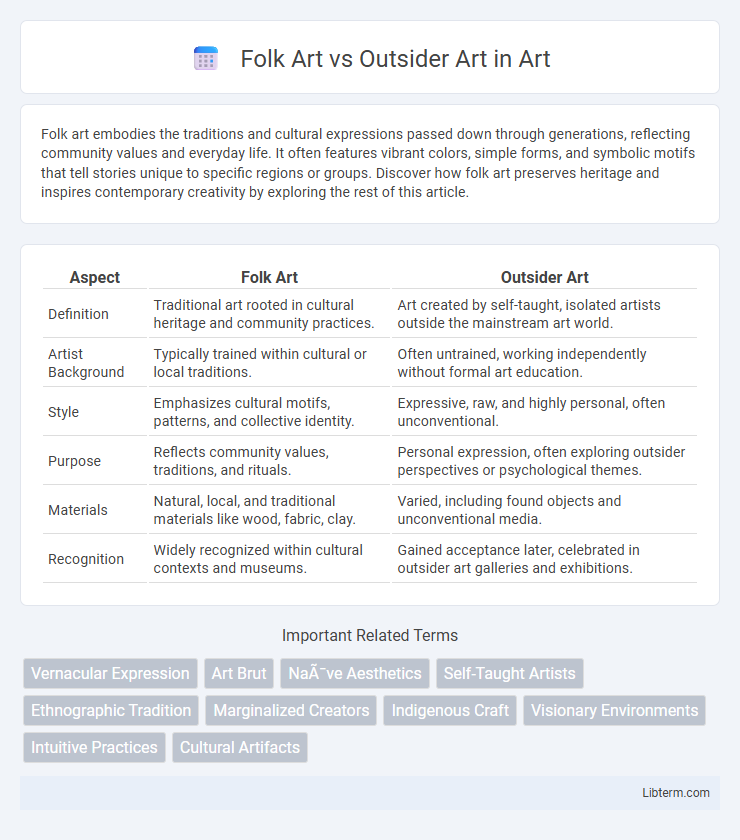Folk art embodies the traditions and cultural expressions passed down through generations, reflecting community values and everyday life. It often features vibrant colors, simple forms, and symbolic motifs that tell stories unique to specific regions or groups. Discover how folk art preserves heritage and inspires contemporary creativity by exploring the rest of this article.
Table of Comparison
| Aspect | Folk Art | Outsider Art |
|---|---|---|
| Definition | Traditional art rooted in cultural heritage and community practices. | Art created by self-taught, isolated artists outside the mainstream art world. |
| Artist Background | Typically trained within cultural or local traditions. | Often untrained, working independently without formal art education. |
| Style | Emphasizes cultural motifs, patterns, and collective identity. | Expressive, raw, and highly personal, often unconventional. |
| Purpose | Reflects community values, traditions, and rituals. | Personal expression, often exploring outsider perspectives or psychological themes. |
| Materials | Natural, local, and traditional materials like wood, fabric, clay. | Varied, including found objects and unconventional media. |
| Recognition | Widely recognized within cultural contexts and museums. | Gained acceptance later, celebrated in outsider art galleries and exhibitions. |
Defining Folk Art: Traditions and Community Roots
Folk art embodies cultural traditions and community roots, often created by self-taught artisans who pass down techniques through generations. It reflects collective identity, featuring objects like quilts, pottery, and wood carvings with symbolic meanings tied to specific regional or ethnic backgrounds. Emphasizing functionality and storytelling, folk art preserves heritage and strengthens social bonds within communities.
Understanding Outsider Art: Creativity Beyond Convention
Outsider art, created by self-taught artists outside the traditional art world, often challenges conventional aesthetics and embraces raw, uninfluenced creativity. Unlike folk art, which is rooted in cultural traditions and community practices, outsider art reflects highly individualistic and spontaneous expressions often produced in isolation. This genre reveals unique perspectives and unfiltered emotions that expand artistic boundaries beyond formal education and established norms.
Origins and Historical Background
Folk Art originates from traditional cultural practices and is created by self-taught artisans within specific communities, often passed down through generations with functional and decorative purposes. Outsider Art, also known as Art Brut, emerged in the mid-20th century, coined by artist Jean Dubuffet to describe works by individuals outside the established art world, including those with no formal training and often marginalized. The historical background of Folk Art is deeply rooted in communal identity and heritage, whereas Outsider Art emphasizes raw, uninfluenced creativity stemming from personal experiences and psychological states.
Materials and Techniques Used
Folk art typically employs traditional materials like wood, fabric, clay, and natural dyes, reflecting cultural heritage and community practices through handcrafting and age-old techniques such as embroidery, woodcarving, and pottery. Outsider art often utilizes unconventional materials including found objects, scrap metal, and recycled items, with artists applying spontaneous, intuitive methods outside formal training, emphasizing raw expression and individuality. The divergence in materials and techniques highlights folk art's rootedness in collective tradition versus outsider art's emphasis on personal vision and experimental innovation.
Cultural Significance and Symbolism
Folk art embodies the cultural heritage and collective identity of a community, often utilizing traditional symbols and motifs passed down through generations to express shared values and historical narratives. Outsider art, created by self-taught artists outside mainstream artistic institutions, frequently conveys deeply personal symbolism reflecting unique life experiences or social marginalization, challenging conventional cultural norms. Both art forms serve as vital cultural documents, preserving diverse worldviews and enriching our understanding of human creativity beyond academic frameworks.
Artistic Intent: Function vs. Expression
Folk Art typically serves a functional or communal purpose, rooted in tradition and cultural heritage, often created by artists within a specific community to preserve collective identity. Outsider Art, by contrast, emphasizes personal expression and individual creativity, produced by self-taught artists working outside the established art world without regard for conventional techniques or societal norms. The artistic intent in Folk Art centers on utility and cultural continuity, whereas Outsider Art prioritizes intuitive, raw emotional expression and uniqueness.
Recognition in the Art World
Folk Art is widely recognized within the art world for its cultural heritage and traditional craftsmanship, often showcased in museums and galleries dedicated to preserving ethnic and regional identities. Outsider Art, created by self-taught artists outside the mainstream art scene, has gained growing acknowledgment through specialized exhibitions and collections emphasizing raw, unconventional creativity. While Folk Art benefits from historical institutional support, Outsider Art's recognition is driven by its unique narratives and challenges to conventional artistic norms.
Collectors and Market Trends
Collectors increasingly distinguish folk art for its traditional cultural significance, while outsider art attracts interest due to its raw, untrained creativity, driving diverse market trends. Folk art sales often emphasize authenticity and heritage, appealing to museum curators and cultural institutions, whereas outsider art commands high prices in contemporary art auctions fueled by demand for unique, unconventional works. Market data from 2023 shows outsider art appreciating faster in value, with collectors seeking pieces that challenge standard art narratives and stimulate new conversations.
Notable Artists in Folk and Outsider Art
Notable folk artists include Grandma Moses, renowned for her nostalgic depictions of rural American life, and Clementine Hunter, celebrated for vibrant portrayals of Southern plantation culture. Outsider art features artists like Henry Darger, whose intricate and imaginative manuscript art gained posthumous fame, and Adolf Wolfli, whose complex, detailed works embody the essence of art brut. Both genres emphasize authenticity and self-taught creativity, with each artist contributing unique cultural and psychological perspectives to the broader art landscape.
The Ongoing Debate: Blurring the Boundaries
Folk Art and Outsider Art often overlap, challenging clear distinctions due to shared characteristics such as self-taught origins and cultural storytelling. The ongoing debate emphasizes how both art forms resist mainstream conventions, leading to blurred boundaries in categorization. Museums and collectors increasingly recognize these nuances, fueling discussions on authenticity and artistic value.
Folk Art Infographic

 libterm.com
libterm.com